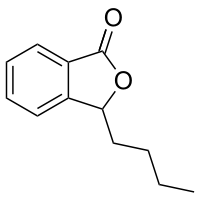Butylphthalide
 | |
| Names | |
|---|---|
| IUPAC name
3-Butyl-2-benzofuran-1(3H)-one | |
| Other names
3-Butylphthalide; 3-n-Butylphthalide | |
| Identifiers | |
| 6066-49-5 | |
| Abbreviations | NBP; BuPh |
| ChemSpider | 55293 |
| Jmol interactive 3D | Image |
| PubChem | 61361 |
| UNII | 822Q956KGM |
| |
| |
| Properties | |
| C12H14O2 | |
| Molar mass | 190.24 g·mol−1 |
| Related compounds | |
| Related compounds |
Phthalide |
| Except where otherwise noted, data are given for materials in their standard state (at 25 °C [77 °F], 100 kPa). | |
| Infobox references | |
Butylphthalide (3-n-butylphthalide or NBP) is one of the chemical constituents in celery oil, along with sedanolide, which is primarily responsible for the aroma and taste of celery.[1]
Studies in animal models suggest that butylphthalide may be useful for the treatment of hypertension[2][3] and may have neuroprotective effects.[4][5][6][7] In 2004, NBP was approved in China for the treatment of cerebral ischemia.
NBP undergoes extensive metabolism in humans.[8] The major metabolites in human plasma was 3-OH-NBP, 10-OH-NBP, 10-CO-NBP, 11-COOH-NBP. The AUC of metabolites was much larger than that of NBP.
Minor side effects were observed in preclinical and clinical studies. The minor bioactivation pathway of NBP was proved to be medicated via sulfation of 3-OH-NBP.[9]
References
- ↑ Wilson, Charles Welthy III (1970). "Relative recovery and identification of carbonyl compounds from celery essential oil". Journal of Food Science 35 (6): 766–768. doi:10.1111/j.1365-2621.1970.tb01989.x.
- ↑ Houston, M (2005). "Nutraceuticals, Vitamins, Antioxidants, and Minerals in the Prevention and Treatment of Hypertension". Progress in Cardiovascular Diseases 47 (6): 396–449. doi:10.1016/j.pcad.2005.01.004. PMID 16115519.
- ↑ D. Tsi and B. K. H. Tan (1997). "Cardiovascular Pharmacology of 3-n-butylphthalide in Spontaneously Hypertensive Rats". Phytotherapy Research 11 (8): 576–582. doi:10.1002/(SICI)1099-1573(199712)11:8<576::AID-PTR174>3.0.CO;2-7.
- ↑ Feng, X; Peng, Y; Liu, M; Cui, L (2011). "Dl-3-n-butylphthalide extends survival by attenuating glial activation in a mouse model of amyotrophic lateral sclerosis". Neuropharmacology 62 (2): 1004–10. doi:10.1016/j.neuropharm.2011.10.009. PMID 22056419.
- ↑ Zhang, T; Yan, W; Li, Q; Fu, J; Liu, K; Jia, W; Sun, X; Liu, X (2011). "3-n-butylphthalide (NBP) attenuated neuronal autophagy and amyloid-beta expression in diabetic mice subjected to brain ischemia". Neurological research 33 (4): 396–404. doi:10.1179/1743132810Y.0000000006. PMID 21535939.
- ↑ Ji, XC; Zhao, WH; Cao, DX; Shi, QQ; Wang, XL (2011). "Novel neuroprotectant chiral 3-n-butylphthalide inhibits tandem-pore-domain potassium channel TREK-1". Acta pharmacologica Sinica 32 (2): 182–7. doi:10.1038/aps.2010.210. PMID 21293470.
- ↑ Xiong, N; Huang, J; Chen, C; Zhao, Y; Zhang, Z; Jia, M; Zhang, Z; Hou, L; Yang, H; Cao, Xuebing; Liang, Zhihou; Zhang, Yongxue; Sun, Shenggang; Lin, Zhicheng; Wang, Tao (2011). "Dl-3-n-butylphthalide, a natural antioxidant, protects dopamine neurons in rotenone models for Parkinson's disease". Neurobiology of Aging 33 (8): 1777. doi:10.1016/j.neurobiolaging.2011.03.007. PMID 21524431.
- ↑ Diao X, Deng P, Xie C, Li X, Zhong D, Zhang Y, Chen X. Metabolism and pharmacokinetics of 3-n-butylphthalide (NBP) in humans: the role of cytochrome P450s and alcohol dehydrogenase in biotransformation. Drug Metab Dispos 2013;41:430-444.
- ↑ Diao X, Pang X, Xie C, Guo Z, Zhong D, Chen X. Bioactivation of 3-n-butylphthalide via sulfation of its major metabolite 3-hydroxy-NBP: mediated mainly by sulfotransferase 1A1. Drug Metab Dispos 2014;42:774-781.